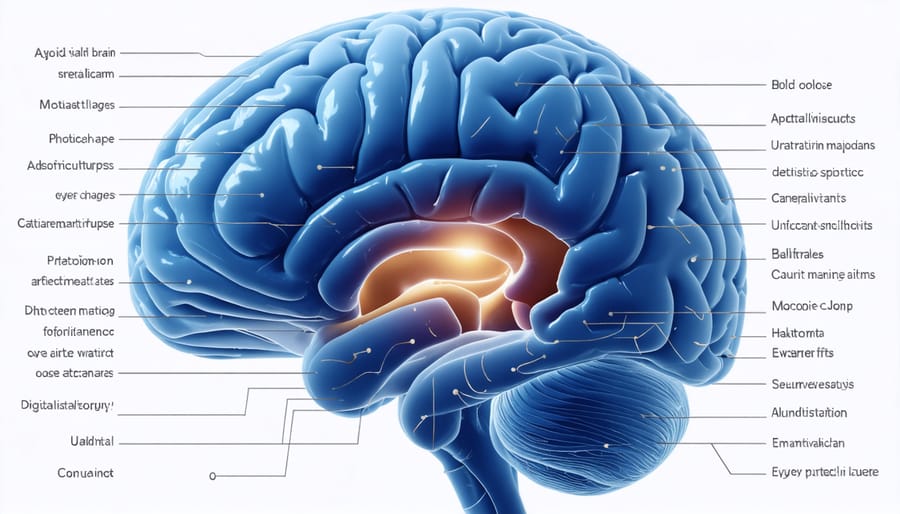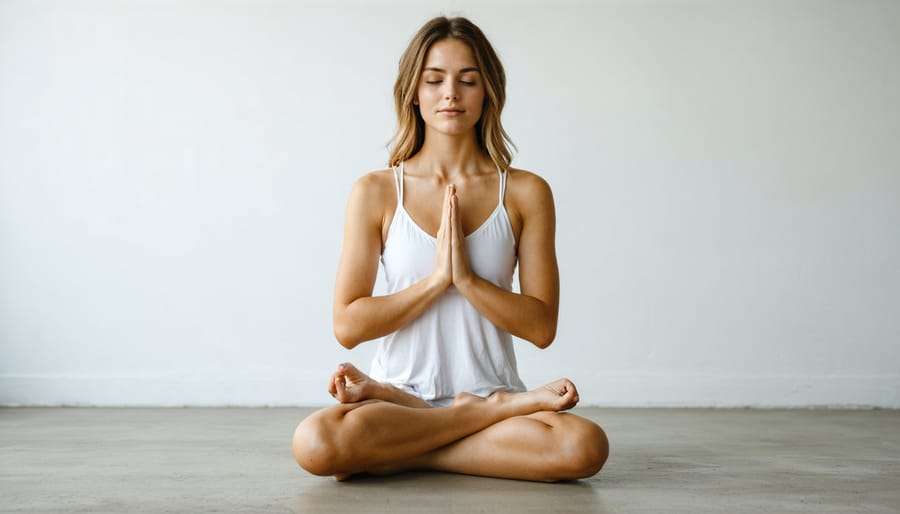Take slow, deep breaths from your diaphragm, focusing on the sensation of air moving in and out. Practice 4-7-8 breathing: inhale for 4 seconds, hold for 7, then exhale for 8. Engage in mindful breathing by observing your breath without judgment, gently redirecting your attention when it wanders. Make physical activity a part of your routine to support both physical and mental well-being through improved breathing. Dedicate just 5-10 minutes each day to conscious breathing exercises to help reduce stress, anxiety, and negative thoughts.
The Science Behind Breathing and Mental Health
Breathing plays a crucial role in regulating our nervous system and mental state. When we experience stress or anxiety, our breathing becomes shallow and rapid, activating the sympathetic nervous system’s “fight or flight” response. This increases heart rate, blood pressure, and muscle tension, intensifying feelings of stress and unease.
In contrast, slow, deep breathing stimulates the parasympathetic nervous system, promoting relaxation and reducing stress levels. As Dr. Richard Brown, an associate clinical professor of psychiatry at Columbia University, explains, “Breathing is a powerful way to control the physiology of our body and our mental state.”
Research supports the mental health benefits of controlled breathing. A 2018 study published in Frontiers in Psychology found that diaphragmatic breathing exercises significantly reduced symptoms of anxiety and depression in participants. Another study from the Journal of Alternative and Complementary Medicine demonstrated that yogic breathing techniques improved mood and decreased perceived stress in healthy individuals.
The mechanisms behind these effects involve the regulation of the autonomic nervous system and the modulation of brain activity. Deep breathing has been shown to increase alpha brain waves, which are associated with relaxation and reduced stress. Additionally, controlled breathing can lower levels of the stress hormone cortisol and increase the release of endorphins, the body’s natural mood-enhancers.
By incorporating breathing exercises into our daily routines, we can harness the power of our breath to promote mental well-being, reduce stress and anxiety, and cultivate a greater sense of inner calm and resilience.


7 Breathing Exercises for Better Mental Health
1. Box Breathing
Box breathing is a simple yet powerful technique that can promote calmness and reduce stress. To practice, inhale deeply through your nose for a count of four, hold your breath for another four counts, then exhale slowly through your mouth for four counts. Finally, hold your lungs empty for a count of four before starting the next cycle. Focusing on this rhythmic pattern helps slow your breathing rate, reducing anxiety and promoting relaxation. The equal counts of four create a sense of balance and groundedness. Incorporating box breathing into your daily routine can help manage stress, improve concentration, and support overall mental well-being.
2. 4-7-8 Breathing
The 4-7-8 breathing technique is a simple yet powerful relaxation exercise. To begin, find a comfortable seated position. Exhale completely through your mouth, making a whoosh sound. Close your mouth and inhale quietly through your nose for a count of four. Hold your breath for a count of seven. Exhale completely through your mouth, making a whoosh sound, for a count of eight. Repeat this cycle three more times for a total of four breaths. This exercise helps to reduce stress and anxiety by promoting a sense of calm and relaxation. Practicing 4-7-8 breathing regularly can improve sleep quality and overall mental well-being, as also discussed in the hidden power of sleep hygiene.
3. Belly Breathing
Belly breathing, also known as diaphragmatic breathing, is a deep breathing technique that engages the diaphragm, a muscle located at the base of the lungs. To practice, lie on your back with one hand on your chest and the other on your belly. Inhale slowly through your nose, allowing your belly to rise while keeping your chest relatively still. Exhale through pursed lips, feeling your belly fall. This type of breathing helps slow your heart rate, lower blood pressure, and promote a sense of calm. Aim for 6-10 deep belly breaths per minute for optimal relaxation.
4. Alternate Nostril Breathing
Alternate nostril breathing, or nadi shodhana pranayama, is a yogic breathing technique that can help balance the left and right hemispheres of the brain. To practice, sit comfortably and use your right thumb to close your right nostril. Inhale deeply through your left nostril, then close it with your right ring finger. Release your thumb and exhale through the right nostril. Inhale through the right nostril, close it, and exhale through the left. This completes one round. Repeat for several minutes, focusing on the sensation of the breath moving through your nostrils. This practice can help calm the mind, reduce stress and anxiety, and promote mental clarity and equilibrium.
5. Resonant Breathing
Resonant breathing, also known as coherent breathing, involves finding your ideal breathing rate for stress reduction. This rate is typically around 5-6 breaths per minute. To find your resonant breathing rate, sit comfortably and breathe in for a count of 5, then out for 5. Adjust the count slightly up or down until you feel a sense of calm and relaxation. Once you’ve found your sweet spot, continue breathing at this pace for 5-15 minutes. Regular practice can help balance the nervous system, reduce stress and anxiety, and promote overall well-being.
6. Pursed Lip Breathing
Pursed lip breathing is a simple yet effective technique that can help slow your breathing rate and promote relaxation. To practice, sit comfortably and inhale slowly through your nose for two counts. Then, purse your lips as if you’re about to whistle and exhale gently through your mouth for four counts. This extended exhalation helps regulate your breathing pattern and can reduce feelings of anxiety or stress. Repeat this cycle for several minutes, focusing on the sensation of the air moving in and out of your body. With regular practice, pursed lip breathing can become a valuable tool in managing stress and promoting mental well-being.
7. Mindful Breathing
Mindful breathing combines focused breathing techniques with mindfulness practices to enhance the mental health benefits. Begin by finding a comfortable seated position and closing your eyes. Focus your attention on your breath, noticing the sensations of the air moving in and out of your body. If your mind wanders, gently redirect your focus back to your breath without judgment. As you breathe, try to maintain a sense of present-moment awareness, observing your thoughts and feelings without getting caught up in them. Practicing mindful breathing regularly can help reduce stress, improve emotional regulation, and cultivate a greater sense of inner peace and well-being.
Tips for Making Breathing Exercises a Daily Habit
To make breathing exercises a consistent part of your daily routine, start by setting aside a specific time each day to practice. Consider linking your breathing exercises to an existing habit, such as after brushing your teeth or before meals. Begin with shorter sessions and gradually increase the duration as you become more comfortable. Find a quiet, comfortable space where you can sit or lie down without distractions. If you struggle to remember, set reminders on your phone or leave notes for yourself in prominent places. Tracking your progress in a journal can help you stay motivated and observe the positive changes in your mental well-being over time. Be patient and kind to yourself; it may take some time to establish a consistent routine, but the benefits are worth the effort. Remember, even a few minutes of conscious breathing each day can make a significant difference in reducing stress, anxiety, and promoting overall mental health.

Conclusion
In conclusion, breathing exercises offer a simple yet powerful way to support mental health and well-being. By incorporating techniques like deep breathing, alternate nostril breathing, and the 4-7-8 method into your daily routine, you can reduce stress, anxiety, and negative emotions while promoting relaxation and mindfulness. Remember, consistency is key when it comes to reaping the full benefits of these exercises. Start with just a few minutes each day and gradually increase the duration as you become more comfortable. Dedicate some time to practice these breathing exercises regularly, and you’ll likely notice improvements in your mental state, emotional resilience, and overall quality of life. Give these techniques a try and experience the positive impact that mindful breathing can have on your mental health journey.

